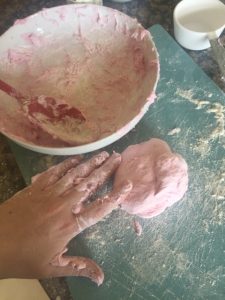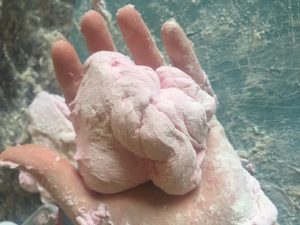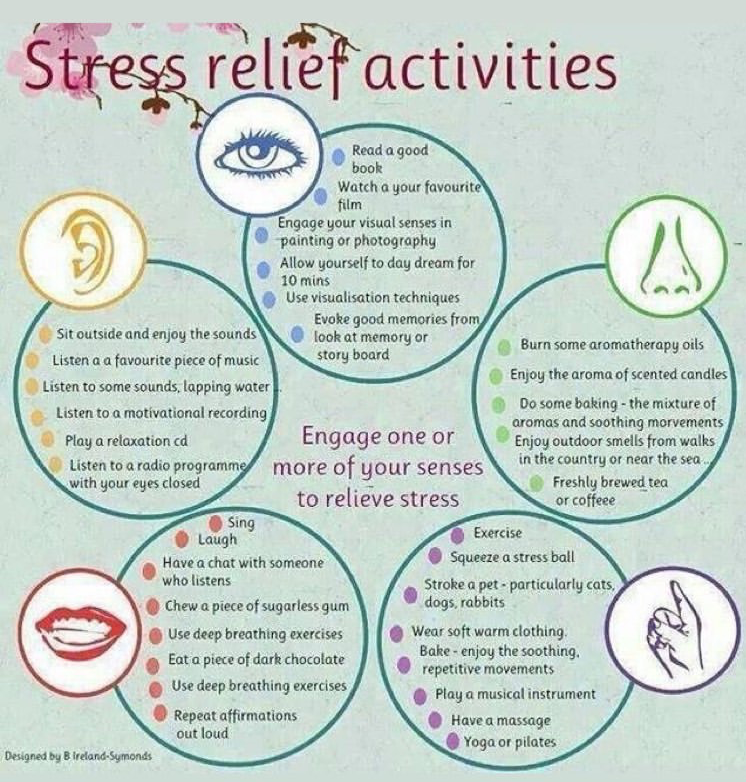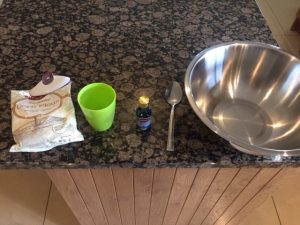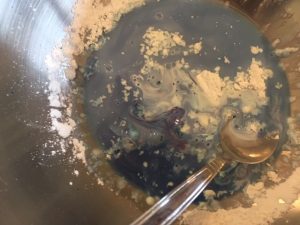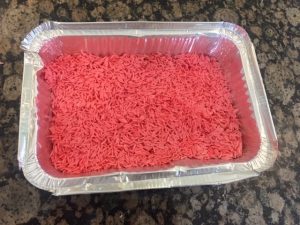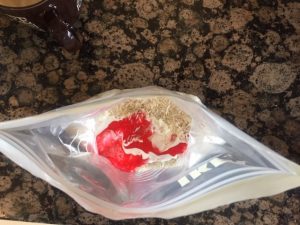| Hi everyone,
Welcome to the calm corner. My name is Sinéad. I am one of the teachers in Outreach and I am studying play therapy part-time. Over the next few weeks I will share some information I have picked up along the way. Each week I will share a new sensory activity and a quick tip. Sensory input is hugely powerful in regulating (calming) us all. When you think about it, even as adults most things we do to relax or treat ourselves are in fact sensory. For example, going for a meal, a massage, getting our hair done, going for a walk, a run, a bubble bath, listening to music, having a beverage. It’s all sensory! So when we are highly overwhelmed (or dysregulated) words are no longer understood or expressed in the same way and sensory input is how we can calm ourselves again. Like everything we are all wonderfully different and unique. So what is regulating for one person may not be for the next! That is completely normal and to be expected. Listen to yourself and notice what works for you and what doesn’t. I hope you may find something useful here for your family. Kindest regards, Sinéad. |
Stress Ball/Squidgy

These can be made quite easily at home. They can be very calming when we are feeling worried, frustrated, angry, anxious, afraid and many other feelings we may experience especially in these strange times. They can be good fun to make too!
What you need:
- Balloons (preferably large high-quality ones as they would be more durable e.g. the slightly more expensive ones in Tesco! But that is not essential.)
- A funnel (you could cut the top of a bottle off)
- Fillings: some examples are;
- Rice, flour, sand, coffee, lentils, cornflour, cornflour with a little water. Whatever you think yourself!
- A spoon
How to make them:
- Pick a balloon and a filling.
- Attach the balloon to the funnel.
- Slowly pour a filling into the funnel.
- You may need to use a spoon handle to push the filling into the balloon.
- When it is near the top remove the funnel.
- Tie a knot in the balloon.
Ta-dah!! Your very own home-made squidgy
You can repeat steps 1-6 using different fillings!
The balloon I had was not a high quality one and it was also very small. This made the process a little bit trickier. It was harder to get the rice in and also the rim of the balloon broke when I was removing it from the bottle. I threw out some of the rice and tied it. The end result helped ease my frustration!
Quick tip!
The Regulation Breath
This is something you can do anywhere if you are feeling in any way dysregulated (worried, anxious, afraid, angry etc.)
- For adults: breathe in through your nose for a count of 4 and then out through your mouth for a count of 8.
- Depending on the age of your child you could try:
- In through the nose for a count of 3 and out through the mouth for 6.
or
- In through the nose for 2 and out through the mouth for 4.
It doesn’t matter which one you do. The important part is that the exhalation is twice the length of the inhalation
Pink Playdough
Playdough can be made quite easily at home using 4 or 5 ingredients. Play dough has many sensory benefits. It can be very calming (regulating) when we are feeling worried, frustrated, angry, anxious, afraid and many other feelings. I added a few drops of lavender which is known for its relaxing qualities. Making playdough can be an enjoyable sensory experience which leaves you with a nice regulation tool/play material!
What you need:
- 1 cup of flour
- ½ a cup of salt
- ½ a cup of water with food colouring in it
- A drop of lavender essential oil (Or lemon, vanilla essence can be used.)
- A spoon, a bowl, a cup
How to make it:
- Mix the flour and salt in a bowl.
- Add a few drops of the food colouring and the scent to the water.
- Slowly mix the water to the flour and salt using the spoon.
- Then knead the mixture.
- Flour the countertop and put the mixture on the countertop.
- Fold and knead the mixture some more.
- Keep doing this until it’s a consistency your happy with.
- If it’s too dry add a little more water.
- If it’s too wet add a little more flour.
- If the colour or scent are too weak.
Ta-dah!! Your very own home-made playdough.
When I took my play dough out of the bowl it was a little dry and I didn’t put in enough of the food colouring. I thought I had normal food colouring but when I went to my press I only had a gel food colouring which I hadn’t used before. I used a small amount of red to try make a pink. I later added too much water which resulted in a way too sticky playdough so then I added more flour. I thought it wasn’t going to work on many occasions. All part of the process! It was a dance of a little flour, a little water and it came together. It smelled nice and I was happy with the consistency. I put my playdough in an air tight reused soup container.
Quick tip!
Legs Up the Wall
This is a lovely quick anti-stress yoga posture. All you need is a floor and a wall! It is something you can do if you are feeling tired or in any way dysregulated (worried, afraid, confused, angry etc.)
- Pick a spot (perhaps put a towel or blanket on tiles/wooden floors)
- Sit on the ground.
- Put one of your hips touching the wall.
- Lie back
- Then lift your legs and swivel your body around and lean your legs against the wall.
- Breathe deeply.
- Stay as long as feels right for you. (2-10 minutes perhaps)
Glitter Jars
Glitter Jars can be made easily at home. They can be very grounding and regulating when we are feeling worried, angry, anxious or afraid. Again making glitter jars can be an enjoyable experience which leaves you with a lovely regulation tool! If you would like to see a professional in action check out this video of Emer McDonagh making a glitter jar. Emer is a child and adolescent play therapist and psychotherapist who works for the Children’s Therapy Centre. https://www.youtube.com/watch?v=MjSgEhkSAI4
What you need:
- A bottle (I used a Vit-Hit bottle)
- Glitter
- Plastic stars or items
- Glue
- Warm water in a jug
- Sellotape or a glue gun
How to make it:
- Pour in glue into the bottle. (About a quarter of the way up)
- Pick a glitter and discuss what worries your child has at the moment.
- Pour in the glitter. (worries)
- If you have different coloured glitter each colour could represent a different worry. You could choose to put more or less in depending on the size of the worry.
- Then discuss supports, so people or things that help us or make us feel better. These are the plastic stars or other items you have. Pop them in.
- Then add warm water up to the neck of the bottle.
- Secure the lid. (Perhaps with a glue gun or sellotape)
- Shake, shake, shake. (The first shakes needs to be a big one!)
- Tell the child to watch the glitter settle.
Ta-dah!! Your very own home-made glitter jar
- The glitter can be like the thoughts and worries we have swirling around our heads.
- The stars (supports) can be hard to see when our heads are very busy but they are always there.
- The glitter settles and watching this calms our nervous system and regulates us. A lovely grounding technique
What you need:
The only issue I had this week was that the glue I used was PVA glue. The PVA gave a cloudy effect reducing visibility. It still worked and is very enjoyable to watch. If using PVA perhaps add in extra ‘support/stars’ as they are a little hard to see due to PVA. Happy making!
Quick tip!
Barefoot walking on grass
This is a lovely grounding activity. All you need is grass, if you don’t have access to grass any floor surface can be used! It is something you can do if you are feeling in any way dysregulated (worried, afraid, confused, angry etc.)
Marshmallow Slime
This is a messy one! I laughed a lot making it. It is extremely sticky until you get past that phase! Slime is wonderful it can be very regulating. Making slime can be an enjoyable experience, although some children don’t like how the slime feels during the mixing phase, when it’s very sticky. This recipe is handy as there are not too many ingredients and they are easily sourced. It also has the massive benefit of being edible!
What you need:
- Two handfuls of marshmallows
- 1 teaspoon of oil(coconut/vegetable/sunflower)
- ½ cup of cornflour
- Food colouring (optional)
- Bowl, spoon, chopping board.
How to make it:
- Put two handfuls of marshmallow in a microwavable dish.
- Put it in the microwave for 30 seconds.
- Take it out and mix it with a spoon.
- Add in 1 teaspoon of oil and mix.
- Add in some of the cornflour and mix.
- Add in the rest of the cornflour gradually.
- Flour the chopping board.
- Take out the mixture and knead with your hands for a good while!
- If the mixture is very sticky it needs more cornflour. Continue to knead the mixture, add more flour if needed. Pull and fold the slime repeatedly.
Ta-dah!! Your very own home-made edible marshmallow slime
What you need:
I tried plain flour the first time but it didn’t work very well. I used cornflour on my second attempt and the result was much better!
Quick tip!
Pick one…
Goop also known as Oobleck is an extremely easy and fun sensory activity. All you need is cornflour and water. That’s it! It is wonderfully engaging, great fun and can be very regulating. It might be helpful to have a boundary on it for example ‘the goop stays in the big bowl/tray’. (It may minimise the clean up after! Obviously that is completely your choice. Outdoor sensory play is also another nice option.) You can add a food colouring if you like.
What you need:
- 2 cups of cornflour
- 1 cup of water
- Food colouring (optional)
- Bowl, spoon, other playing items perhaps.
How to make it:
- Put two cups of cornflour in a bowl.
- Add in one cup of water (with food colouring in it if you wish).
- Mix!
- Play
- It will be amazingly solid and liquid nearly simultaneously! Magic!
- If it’s too runny add more cornflour.
- If it’s too hard add a little more water.
Ta-dah!! Your very own home-made goop/ oobleck
What you need:
I tried this with my 5-year-old niece and 11-month old nephew and they both loved it! My nephew was playing with a spoon and bought it over by chance and it really aided the exploration. My niece then got the clever idea of using her plastic play dough molds. Great fun! I did put a limit on the amount of them that went into the mixture though to keep the clean up after manageable! I think I gave her the choice of picking any four or five molds!
Quick tip!
Niall Breslin (Bressie) has written a beautiful children’s book called ‘The Magic Moment’. In it he shares a mindfulness technique that could be useful for children when they are feeling anxious, sad or afraid. I would fully recommend this book.
The technique he used in the book is very simple.
- Ask your child to close their eyes and think of a really happy or fun day.
- When they’ve got one picked tell them to squeeze their thumb and their finger together really tightly.
- Then take ten deep breaths and keep thinking of that ‘magic moment’.
- Tell your child any time they feel nervous, worried, sad or any difficult emotion they can use the magic moment trick.
The story and illustrations are great. There is also a powerful poem in the book that goes with the technique!
This won’t work for every child but it might be very helpful for some children.
As an extra for this week I thought I would share some more benefits of sensory play. I got this from the Children’s Therapy Centre Instagram account.
Colourful Scented Rice
Colourful scented rice is an extremely easy sensory activity. All you need is rice, paint and scent. It produces a wonderfully engaging sensory tool.
What you need:
- 1 cup of rice
- Some paint
- Scent (extract)
- Zip lock bag, spoon, a tray, a cup and a bowl.
How to make it:
- Put one cup of rice into the zip lock bag.
- Add in the paint and scent.
- Close the bag and mix it around.
- Tip mixture into a tray spread it out and leave to dry.
- When dry pour into a bowl and play with this sensory delight!
- (You could do a few different batches choosing different colours and scents)J
- If you want, you can match the colour and the scent. For example, orange with orange extract, yellow with lemon extract etc.
- If you need more paint or extract(scent) add in more at any stage.
Ta-dah!! Your very own home-made colourful scented rice
What you need:
I enjoyed making this. It was quick and easy. I chose pink paint and a rose essential oil. When I was mixing the rice in the sealed bag I thought I needed more paint. I instead opened the bag and let in a little air. I then resealed it and it mixed much better. Happy making!
Quick tip!
Would you believe there are 20 therapeutic powers of play. 20!
One of them is positive emotions.
Positive emotions like excitement, happiness, amusement, interest, engagement, silliness and joy are a selection of positive emotions that can be experienced while playing. Of course less positive emotions like frustration and disappointment can also be experienced. They are welcomed!
Play however naturally generates positive emotions and positive emotions counteract stress. It is hard to be sad or anxious if you are having lots of fun!
So here are a few fun simple games that also promote attachment!
- Pompom or cotton ball football
You need one pompom/cotton ball, two straws and two players!
Basically you play football with the pompom by blowing through the straw!
You can play on a table, the floor, anywhere you want. Make goals or not! Great fun!
- Bubble Popping
Blow bubbles and tell your child to pop them with their head, foot, baby finger, elbow, nose etc.
You could also swap roles!
- Bean bag name game.
Get a bean bag (or something similar) and put it on your head.
Pick a special word for example ‘Popcorn’.
Tell your child when you say the special word ‘Popcorn’ you are going to lower your head and they have to try to catch the bean bag!
Start talking about anything. (Real or made up.) Then say the word ‘Popcorn’ at some point. Play again, you can change the special word.
Swap if they want to!
My Mantra Bracelet
Mantra bracelets are something I have used personally and have found them to be very powerful. As part of a college assignment I had to do a project on big feelings and the feeling I was learning about was fear. I did this activity with my class of 18 adults aged from 25-55. At the next module I received lots of positive feedback on how the bracelets had supported my classmates with their fears over the previous weeks. I was delighted and had found my bracelet surprising powerful too.
A mantra is a statement repeated frequently. The idea behind the mantra bracelet is that it could be a visual, felt reminder or support that can be easily worn. So if you or your child are experiencing fear this could be a helpful activity for you. I bought my material in Tesco, great value and the string is included in the cupcake shaped one.
What you need:
- Beads
- String
- A quiet space and time.
- A piece of paper and a pen (optional)
How to do it:
- Close your eyes. (Instruct your child to close their eyes)
- Take a deep breath.
- Think about what you are most afraid of in that moment. (It can be something big or small)
- Then think of a ‘mantra’ a sentence that would support you when you are having this fear.
- For example, my fear was: I am not good enough.
- My mantra was: I am good enough.
- My mantra later that evening developed into… it is good enough (about my college work)
- When the child has found the right sentence for them (A positive powerful sentence that would be helpful) you could write it down.
- Then start to look at the beads and say the mantra over and over, aloud or in your head while you make your bracelet.
- Tie it up and there you have it.
- It could be used dealing with other big emotions too.
Ta-dah!! Your very own home-made meaningful mantra bracelet
What you need:
I enjoyed making my bracelet. My mantra this time was ‘All will be well’. I unfortunately ran out of the elastic string that comes in the cupcake bead set. So I used wool instead. The wool worked well but I was unable to use the smaller beads as I couldn’t get the wool through!
Quick tip!
Calm Box
Over the last seven weeks we have explored different sensory activities. Some may have been regulating and some not! My quick tip for our last week is to make a calm box. Put anything your child finds regulating in it. This can be the stress ball, glitter jar or it can be other things that your child finds calming.
An example of some potential items are; a small selection of arts materials, play dough, slime, a fidget, a certain smell, a teddy, a blanket, a book.
The list is as endless as it is personal. You could start with one or two bits and let the box naturally grow as you and your child discover new regulating items or activities.
The box itself can be a reused shoe box or any type of box. Your child could decorate it, or not. You could make a name tag for it e.g. ‘____’s Calm Box’ or not. Calm boxes can be a great resource for children to go to help them regulate.
Seeing as this is the last week of Calm Corner I am going to share some extra, super quick and easy sensory play ideas that you might like to try out over the Summer.
Shaving foam
Shaving foam with food colouring
Shaving foam in a zip lock bag (With or without paint/food colouring)
Moon Sand:
1 cup of flour
¼ cup of baby oil
Food colouring (optional)
Mix
Cereal Sand
Put cereal (Cheerio’s) in a food blender.
Mix and play
*Bonus of being edible!
Snow dough:
½ cup of hair conditioner
1 cup of corn flour
Food colouring (optional)
Mix
Water play
Put food colouring in a basin or the sink.
Add water and play.
I wrote about positive emotions last week and mentioned that there are 20 therapeutic powers of play. So for our last week of the Calm Corner I decided to list the 20 powers of play just in case you were interested in what they are.
The 20 therapeutic Powers of Play are:
- Self-expression
- Access to the unconscious
- Direct teaching
- Indirect teaching
- Catharsis
- Abreaction
- Positive emotions
- Counterconditioning fears
- Stress inoculation
- Stress management
- Therapeutic relationship
- Attachment
- Social Competence
- Empathy
- Creative problem solving
- Resiliency
- Moral Development
- Accelerated psychological development
- Self-regulation
- Self-esteem
All from play! I find it fully fascinating!
Lastly I will leave you with some thoughts around play, what it is and the idea of having a special play time with your child.
We are all very familiar with play but I believe it’s worth stopping and asking the question ‘what is play?’
It has been said that play is in fact so complex it defies definition.
That said three words that seem very important in play are freedom, choice and control.
With this in mind, if you wish, try having a special play time with your child.
For 20 minutes a week (or more!) let your child be the ‘boss of play’.
You follow their lead! Give them 100% of your attention. Comment on what they are doing like a football commentator might. Simply notice what they are doing e.g. ‘Oh you’re going to do some colouring in. You picked the red. Oh you are really concentrating…’
If they chose to involve you in their play do what they say! J You can whisper and ask for direction if you’re not sure what to do. For example, if they say ‘Welcome to my shop what do you want to buy today?’ You can put up your hand to your mouth and whisper ‘What do I want?’ They will either tell you what to buy or say that you can decide. It will feel funny at the start but they will more than likely grow to love having the control. You can also ask for directions or clarification on anything in the play by putting your hand to your mouth and whispering. The reason for doing this is to quickly get out of ‘role’ and then return.
Importantly you are the boss of safety and time! You bring in the safety rule whenever needed. In play therapy we call this type of play non-directive. Nothing comes from us. For that 20 minutes they are fully the boss! This can be really powerful in building self-esteem, attachment, self-expression, decision making, self-awareness and much more!
This may be something you already do or something you aren’t interested in. All good either way. I just said I would share the idea; it may be worth a whirl!
Wishing you and your family a lovely Summer.
Kindest regards and best wishes,
Sinéad.


















